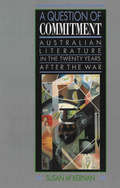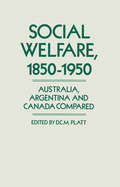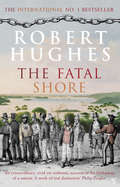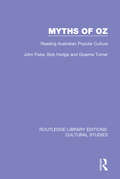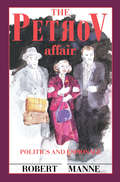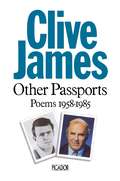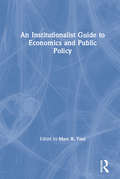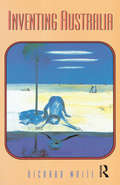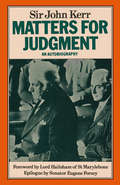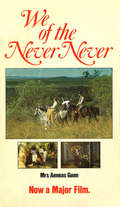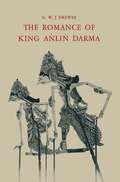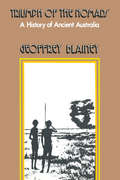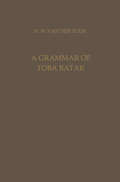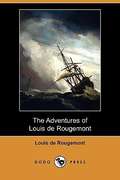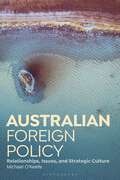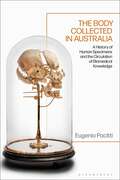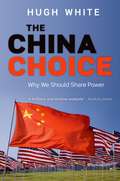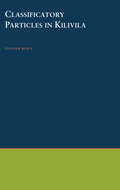- Table View
- List View
A Question of Commitment: Australian literature in the twenty years after the war
by Susan LeverIn the years since the Second World War, Australia has seen a period of literary creativity which outshines any earlier period in the nation's literary history. This creativity has its beginnings in the arguments and alignments which emerged at the end of the War, and the changes in perceptions of art and society which occurred during the fifties and early sixties.A Question of Commitment examines the attitudes of writers as diverse as James McAuley, Frank Hardy, Judith Wright, Patrick White and A. D. Hope, as they responded to a changing Australian society during the postwar years. Through their work and that of many others, it considers the debates about literary nationalism, the artistic politics of the Cold War, the threat of technology to art in the Atomic Age, and the nature of the writer's role in the new society. It documents the way in which the political commitments of some writers and the resistance to commitment of others were challenged by political and social changes of the late fifties.Susan McKernan's lively exploration of Australia's writers in a time of innovation provides the reader with the context needed to understand the creative choices they made and, in so doing, introduces wider intellectual and cultural issues which remain relevant to this day.
A Question of Commitment: Australian literature in the twenty years after the war
by Susan LeverIn the years since the Second World War, Australia has seen a period of literary creativity which outshines any earlier period in the nation's literary history. This creativity has its beginnings in the arguments and alignments which emerged at the end of the War, and the changes in perceptions of art and society which occurred during the fifties and early sixties.A Question of Commitment examines the attitudes of writers as diverse as James McAuley, Frank Hardy, Judith Wright, Patrick White and A. D. Hope, as they responded to a changing Australian society during the postwar years. Through their work and that of many others, it considers the debates about literary nationalism, the artistic politics of the Cold War, the threat of technology to art in the Atomic Age, and the nature of the writer's role in the new society. It documents the way in which the political commitments of some writers and the resistance to commitment of others were challenged by political and social changes of the late fifties.Susan McKernan's lively exploration of Australia's writers in a time of innovation provides the reader with the context needed to understand the creative choices they made and, in so doing, introduces wider intellectual and cultural issues which remain relevant to this day.
Social Welfare, 1850–1950: Australia, Argentina and Canada Compared
by Desmond Christopher PlattThis historical study of the development of social welfare systems in divergent countries draws on a variety of essays to examine the work of each country in turn, followed by a comparison of all three and an examination of social experiments in regions of recent settlement.
The Fatal Shore: The Epic Of Australia's Founding (Harvill Panther Ser.)
by Robert HughesThe authoritative, epic history of the British colonisation of Australia.In 1787, the twenty-eighth year of the reign of King George III, the British Government sent a fleet to colonise Australia.Documenting the brutal transportation of men, women and children out of Georgian Britain into a horrific penal system which was to be the precursor to the Gulag and was the origin of Australia, The Fatal Shore is the definitive, masterfully written narrative that has given its true history to Australia.'A unique phantasmagoria of crime and punishment, which combines the shadowy terrors of Goya with the tumescent life of Dickens' Peter Ackroyd, The Times‘An enthralling account… brimming over with rare and pungent characters, and tales of pathos, bravery, and horror’ Peter Matthiessen, author of The Snow Leopard
Myths of Oz: Reading Australian Popular Culture (Routledge Library Editions: Cultural Studies)
by John Fiske Bob Hodge Graeme TurnerThis book, first published in 1987, sets out to examine and extend our understanding of Australian popular culture, and to counter the long-established, traditional criticism bewailing its lack. The authors argue that the 'knocker's' view started from an elitist viewpoint, yearning for Australia to aspire to a European culture in art, music, literature and other traditional cultural fields. They argue however that there are other definitions of culture that are more populist, more comprehensive, and which represent a vitality and dynamism which is a true reflection of the lives and aspirations of Australians. Myths of Oz offers no comprehensive definition of Australian culture, but rather a way of interpreting its various aspects. The barbeque or the pub, an expedition to the shops or a day at the beach, the home, the workplace or the job queue; all these intrinsic parts of Australian life are examined and conclusions drawn as to how they shape or are shaped by what we call popular culture. The authors look too at monuments and symbols, from Ayers Rock to the Sydney Opera House, which both shape and reflect Australian culture, while a chapter on the Australian accent shows how language and terminology play a powerful role in establishing cultural standpoints. A particular strength of this book is that while delivering a provocative and stimulating series of viewpoints on popular culture, it also makes use of current academic tools and methodology to ensure that we gain new insights into the meanings and pleasures we derive from our everyday experiences.
Myths of Oz: Reading Australian Popular Culture (Routledge Library Editions: Cultural Studies)
by John Fiske Bob Hodge Graeme TurnerThis book, first published in 1987, sets out to examine and extend our understanding of Australian popular culture, and to counter the long-established, traditional criticism bewailing its lack. The authors argue that the 'knocker's' view started from an elitist viewpoint, yearning for Australia to aspire to a European culture in art, music, literature and other traditional cultural fields. They argue however that there are other definitions of culture that are more populist, more comprehensive, and which represent a vitality and dynamism which is a true reflection of the lives and aspirations of Australians. Myths of Oz offers no comprehensive definition of Australian culture, but rather a way of interpreting its various aspects. The barbeque or the pub, an expedition to the shops or a day at the beach, the home, the workplace or the job queue; all these intrinsic parts of Australian life are examined and conclusions drawn as to how they shape or are shaped by what we call popular culture. The authors look too at monuments and symbols, from Ayers Rock to the Sydney Opera House, which both shape and reflect Australian culture, while a chapter on the Australian accent shows how language and terminology play a powerful role in establishing cultural standpoints. A particular strength of this book is that while delivering a provocative and stimulating series of viewpoints on popular culture, it also makes use of current academic tools and methodology to ensure that we gain new insights into the meanings and pleasures we derive from our everyday experiences.
The Petrov Affair: Politics and Espionage
by Robert ManneThe Petrov Affair: Politics and Espionage is a memoir of the Petrov Affair, a historical event that involves the defection of Vladimir Petrov, a colonel in the Soviet intelligence service in Sydney, and the announcement of his defection ten days later by Australian Prime Minister Robert Menzies. With information gathered from different reliable sources, the book details in chronological order the Petrov's defection - the events that occurred before and the factors that led to it; its announcement; and the implications of this event for politics and espionage. The text also explains how the affair affected the Australian people and the world; the conclusion of this event; and the events that happened after it. The book is recommended for historians and history enthusiasts who would want to know more about this particular event. The text is also recommended for experts who delve in the Cold War and the Soviet Union.
Other Passports: Poems 1958-1985 (Picador Bks.)
by Clive JamesClive James's unforgettable poetry collection, which gained him comparison to Byron and status as a 'true poet' demonstrates his wide range of interests and knowledge while never compromising his trademark wit and humour. Other Passports explores his lyrical style of poetry, alongside parodies, imitations and lampoons.
An Institutionalist Guide to Economics and Public Policy
by Marc R. ToolThis narrative recounts the 18th and 19th century "shipping out" of Pacific islanders aboard European and American vessels, a kind of "counter-exploring", that echoed the ancient voyages of settlement of their island ancestors.
An Institutionalist Guide to Economics and Public Policy
by Marc R. ToolThis narrative recounts the 18th and 19th century "shipping out" of Pacific islanders aboard European and American vessels, a kind of "counter-exploring", that echoed the ancient voyages of settlement of their island ancestors.
Inventing Australia: Images And Identity, 1688-1980 (Australian Experience Ser. #No. 3)
by Richard White'White sets himself a most ambitious task, and he goes remarkably far to achieving his goals. Very few books tell so much about Australia, with elegance and concision, as does his' - Professor Michael Roe'Stimulating and informative. an antidote to the cultural cringe' - Canberra Times'To be Australian': what can that mean? Inventing Australia sets out to find the answers by tracing the images we have used to describe our land and our people - the convict hell, the workingman's paradise, the Bush legend, the 'typical' Australian from the shearer to the Bondi lifesaver, the land of opportunity, the small rich industrial country, the multicultural society.The book argues that these images, rather than describing an especially Australian reality, grow out of assumptions about nature, race, class, democracy, sex and empire, and are 'invented' to serve the interests of particular groups.There have been many books about Australia's national identity; this is the first to place the discussion within an historical context to explain how Australians' views of themselves change and why these views change in the way they do.
Inventing Australia
by Richard White'White sets himself a most ambitious task, and he goes remarkably far to achieving his goals. Very few books tell so much about Australia, with elegance and concision, as does his' - Professor Michael Roe'Stimulating and informative. an antidote to the cultural cringe' - Canberra Times'To be Australian': what can that mean? Inventing Australia sets out to find the answers by tracing the images we have used to describe our land and our people - the convict hell, the workingman's paradise, the Bush legend, the 'typical' Australian from the shearer to the Bondi lifesaver, the land of opportunity, the small rich industrial country, the multicultural society.The book argues that these images, rather than describing an especially Australian reality, grow out of assumptions about nature, race, class, democracy, sex and empire, and are 'invented' to serve the interests of particular groups.There have been many books about Australia's national identity; this is the first to place the discussion within an historical context to explain how Australians' views of themselves change and why these views change in the way they do.
We Of The Never Never (Classic Ser.)
by Aeneas GunnNewly married, Jeannie Gunn accompanies her husband to 'The Elsey', the huge cattle station in the Northern Territory, several hundred miles from the nearest town. She is one of the few white women in the area and her presence is at first resented by the stockmen until her warmth and spirit win their affection and respect. This is one of the few autobiographies written by a woman to chronicle the life of the pioneers of the outback. In the style of the bush storyteller, Mrs Gunn conveys with moving simplicity the beauty and cruelty of the land, and the isolation and loneliness, comradeship and kindness of the early settlers.
A Grammar of Toba Batak (Verhandelingen van het Koninklijk Instituut voor Taal-, Land- en Volkenkunde)
by Herman Neubronner van der TuukThe Adventures of Louis de Rougemont
by Louis De RougemontLouis de Rougemont (1847-1921) was a would-be explorer who claimed to have had adventures in Australasia. "de Rougemont" was born Henri Louis Grin in 1847 in Suchy, Switzerland. <P> <P> In 1898 he began to write about his invented adventures in the British periodical The Wide World Magazine under the name Louis de Rougemont. He described his alleged exploits in search of pearls and gold in New Guinea and claimed to have spent thirty years living with Indigenous Australians in the Australian outback. He claimed that the tribe with whom he had lived had worshipped him as a god. He also claimed to have encountered the Gibson expedition of 1874. Various readers expressed disbelief in his tales from the start, for example, claiming that no one can actually ride a turtle. He had also claimed to have seen flying wombats. The fact that he could not place his travels on the map aroused suspicion. Readers' arguments in the pages of London newspaper, the Daily Chronicle, continued for months.
Australian Foreign Policy: Relationships, Issues, and Strategic Culture
by Michael O'KeefeHow does Australia's unique geographical, cultural and historical position influence its approach to foreign policy? What key challenges does Australia face on the world stage, and how can it overcome them? Reflecting the messy reality of foreign policy decision-making, this book helps you to understand the changes and continuities in Australia's approach. For example, does the US withdrawal from Vietnam in 1973 and collapse of South Vietnam continue to cast a shadow over Australian foreign policy, or is it relevant only in understanding the dynamics of the cold war? Using an Australian Strategic Culture framework, O'Keefe sheds light on the characteristics that make Australia behave in a way different to any other country and equips you with analytic skills to understand the main debates, such as:- In what sense could Australia be seen as a 'good' international citizen? - Have national interests trumped global responsibilities? - How does the intersection between civil society and public opinion interact with foreign policy making?This book is essential reading if you are a student of Australian foreign policy, as well as of broader Australian domestic politics and international relations.
Australian Settler Colonialism and the Cummeragunja Aboriginal Station: Redrawing Boundaries (First Nations and the Colonial Encounter)
by Fiona DavisIn 1938, the anthropologist Norman Tindale gave a classroom of young Aboriginal children a set of crayons and asked them to draw. The children, residents of the government-run Aboriginal station Cummeragunja, mostly drew pictures of aspects of white civilization boats, houses and flowers. What now to make of their artwork? Were the children encouraged or pressured to draw non-Aboriginal scenes, or did they draw freely, appropriating the white culture they now lived within? Did their Aboriginality change the meaning of their art, as they sketched out this ubiquitous colonial imagery? Australian Settler Colonialism and the Cummeragunja Aboriginal Station traces Cummeragunja's history from its establishment in the 1880s to its mass walk-off in 1939 and finally, to the 1960s, when its residents regained greater control over the land. Taking in oral history traditions, the author reveals the competing interests of settler governments, scientific and religious organizations, and nearby settler communities. The nature of these interests has broad and important implications for understanding settler colonial history. This history shows white people set boundaries on Aboriginal behaviour and movement, through direct legislation and the provision of opportunities and acceptance. But Aboriginal people had agency within and, at times, beyond these limits. Aboriginal people appropriated aspects of white culture including the houses, the flowers and the boats that their children drew for Tindale - reshaping them into new tools for Aboriginal society, tools with which to build lives and futures in a changed environment.
The Body Collected in Australia: A History of Human Specimens and the Circulation of Biomedical Knowledge
by Eugenia PacittiOffering insight into nineteenth- and early twentieth-century medical school dissecting rooms and anatomy museums, this book explores how collected human remains have shaped Western biomedical knowledge and attitudes towards the body. To explore the role Australia played in the narrative of Western medical development, Pacitti focuses on how and why Australian anatomists and medical students obtained human body parts. As medical knowledge circulated between Australia and Britain, the colony's physicians conformed to established specimen collecting practices and diverged from them to form a distinct medical identity. Interrogating how these literal and figurative bones of contention have left an indelible mark on the nation's medical profession, collecting institutions, and communities, Pacitti sheds new light on our understanding of Western medical networks and reveals the opportunities and challenges historic specimen collections pose in the present day.The Body Collected in Australia is a cultural history of collectors and collections that deepens our understanding of the ways the living have used the dead to comprehend the intricacies of the human body in illness and good health.
Classificatory Particles In Kilivila
by Gunter SenftCommon among the world's languages is the phenomenon of classification, a partly or fully grammatical division of the noun lexicon into distinct classes that ultimately derives from the human need to classify and filter data on various levels while communicating. In this book, Senft describes and develops a grammar of classificatory particles in Kilivila, an Austronesian language of the Trobriand Islanders in Papua New Guinea. Drawing largely on his anthropological and linguistic fieldwork in the islands, and emphasizing the use of classifiers in a social context, Senft provides quantitative data and a statistical profile of the status and use of these particles, and the classifier system that employs them.
